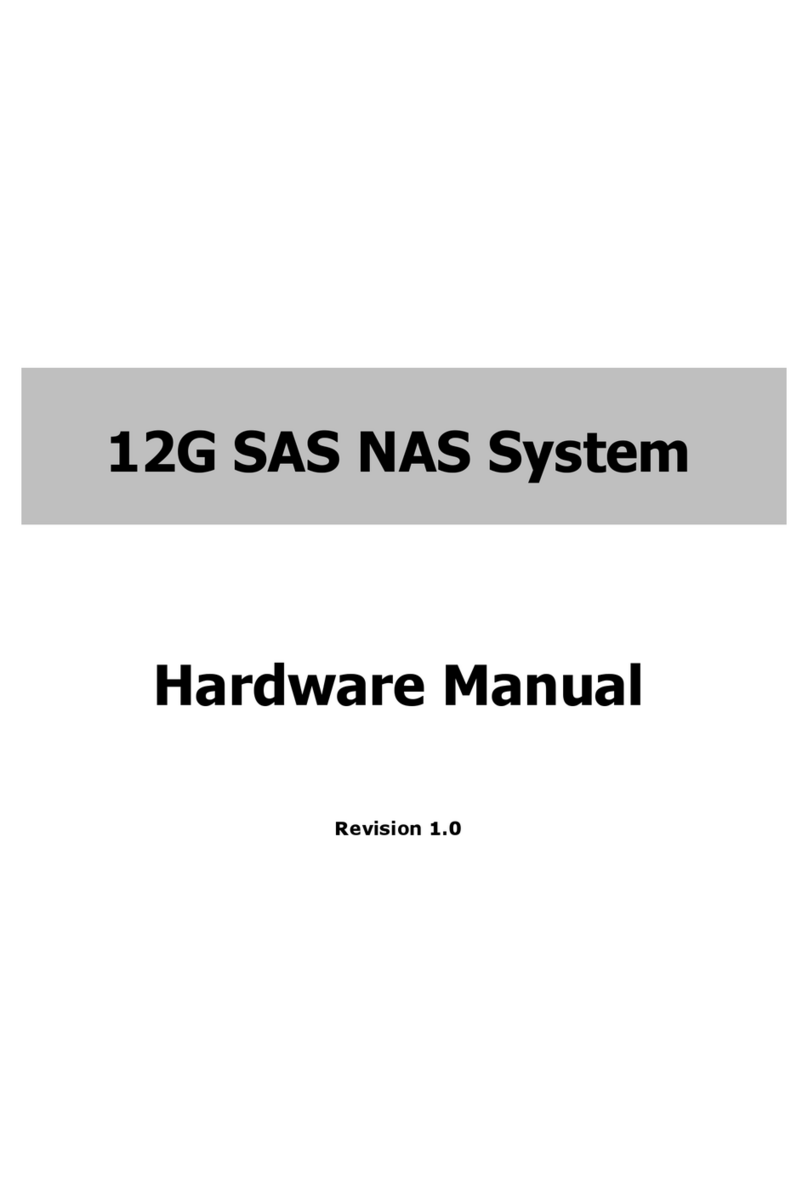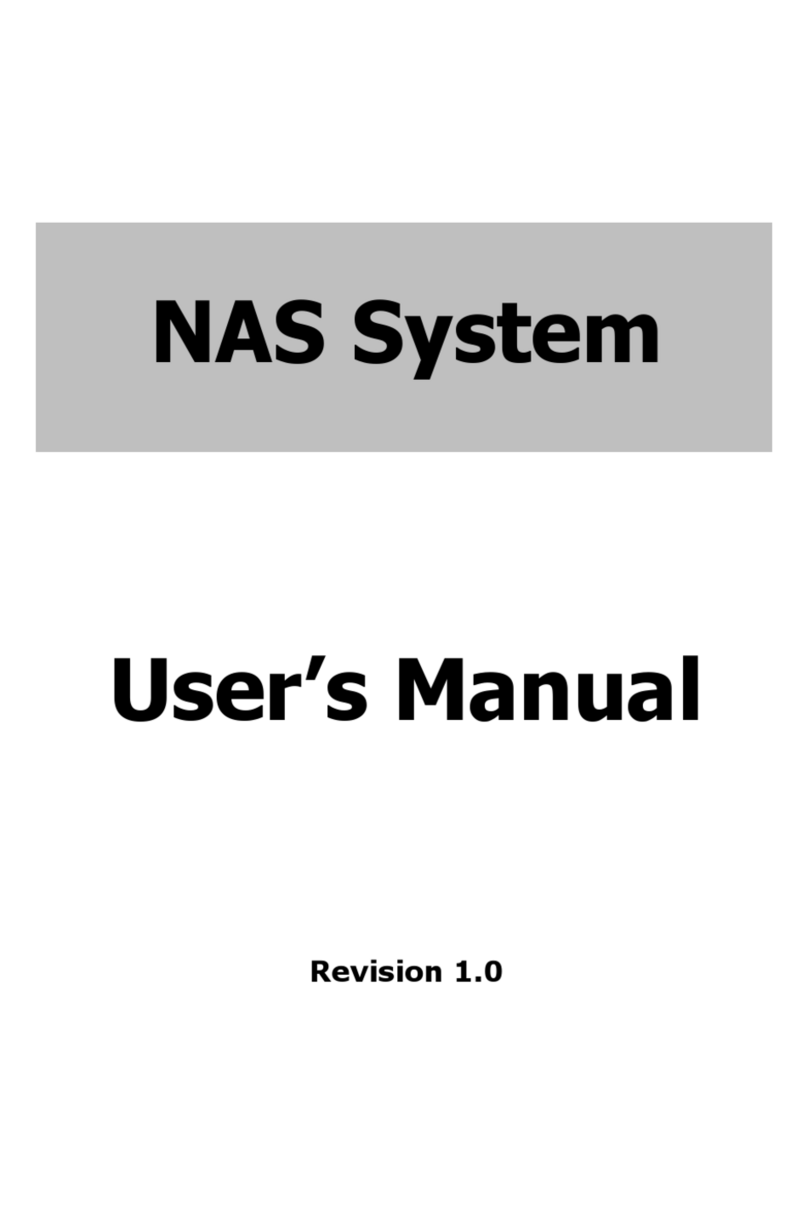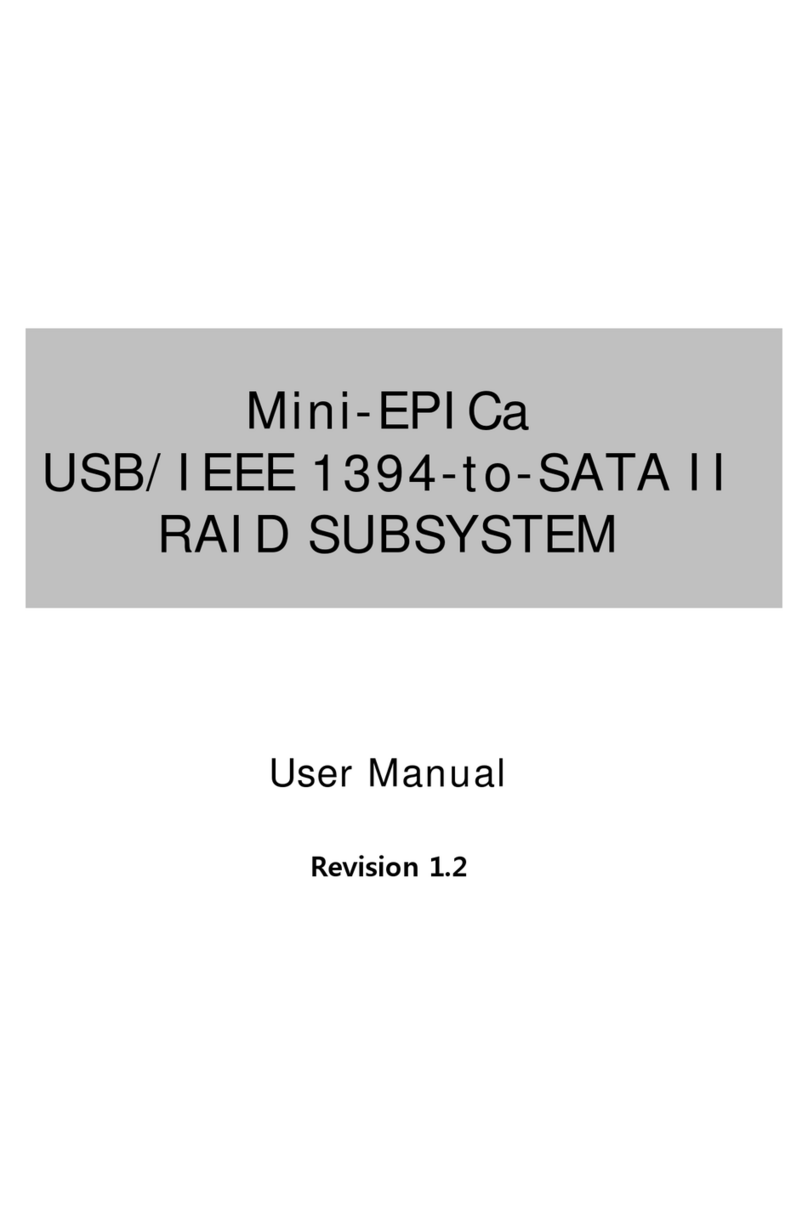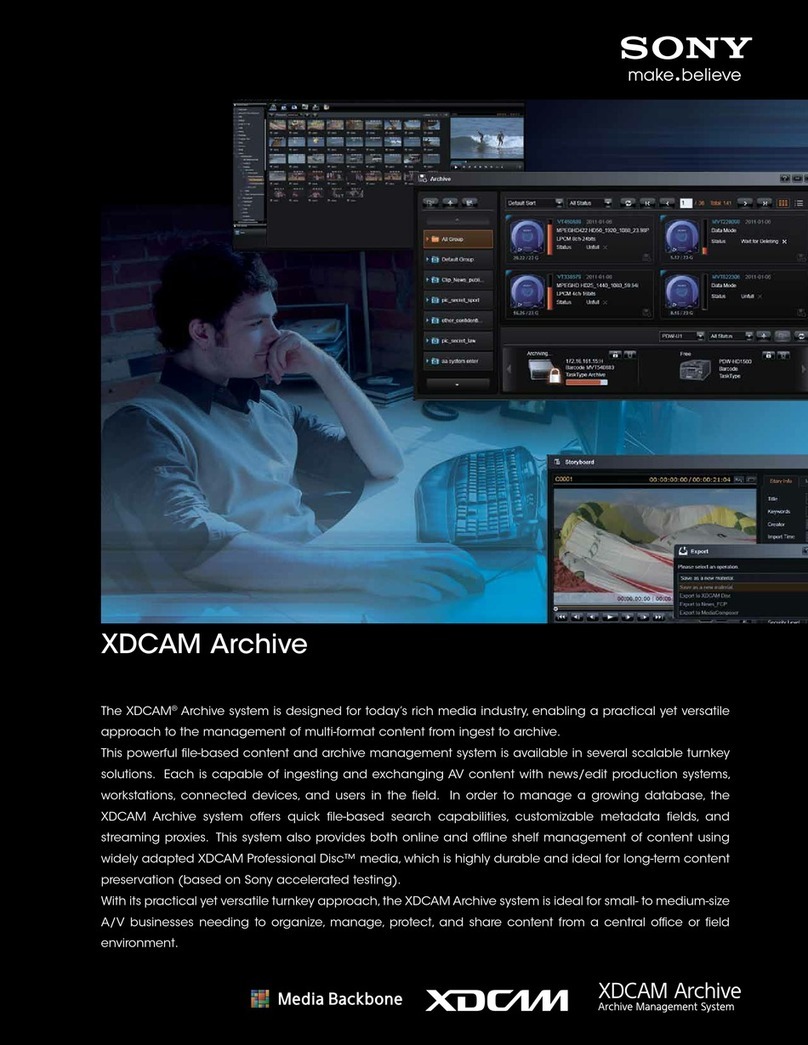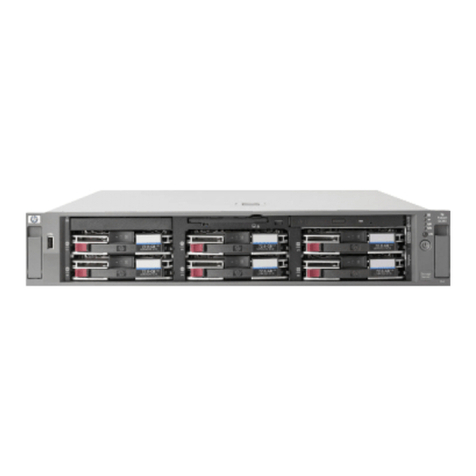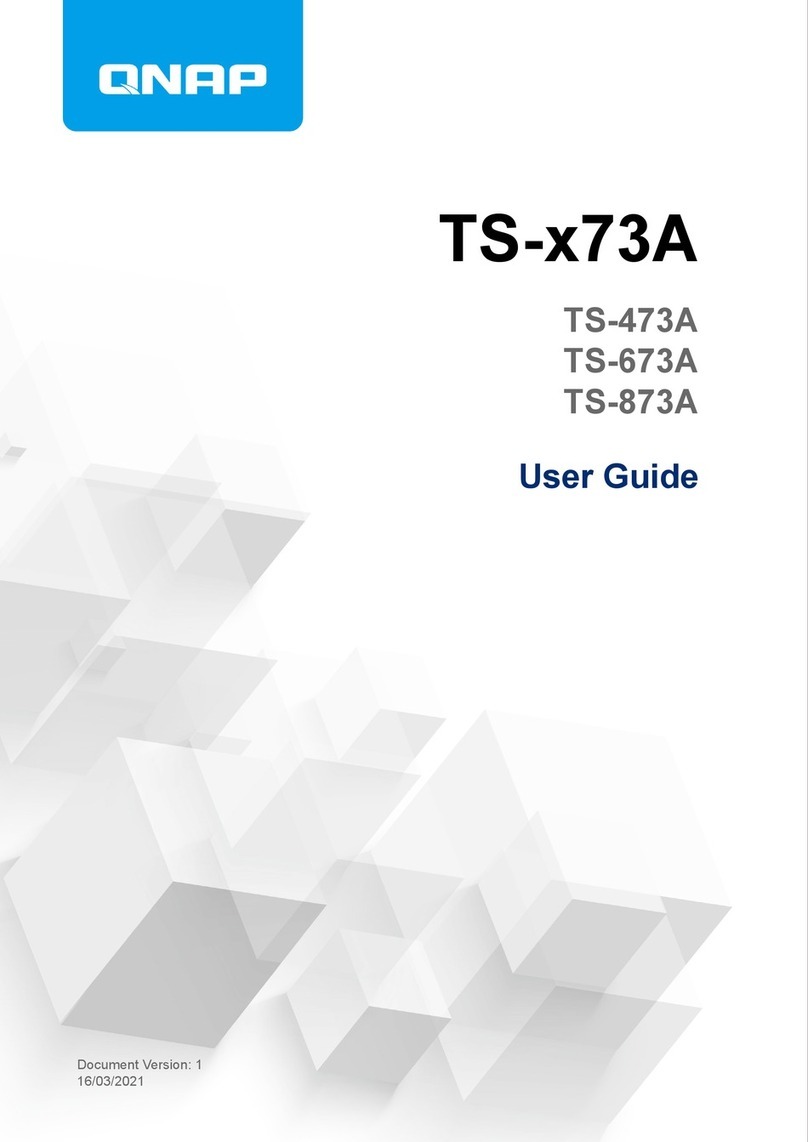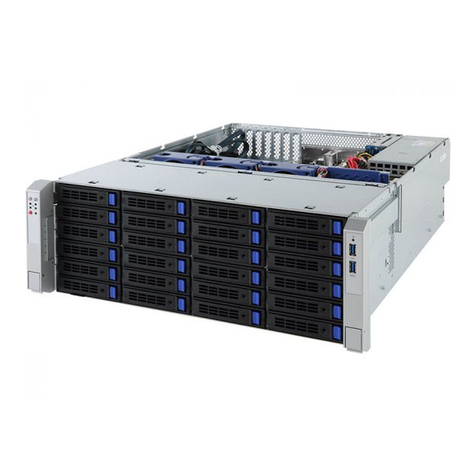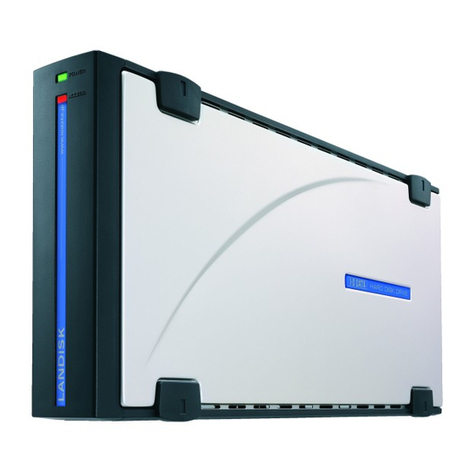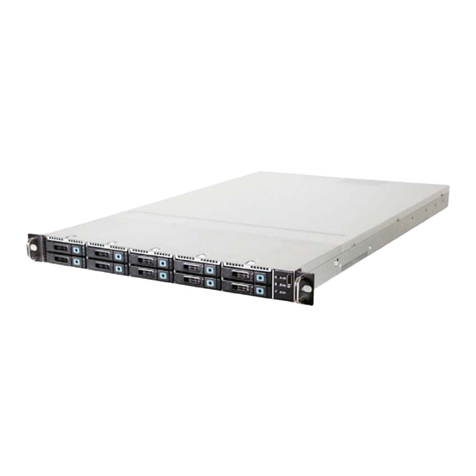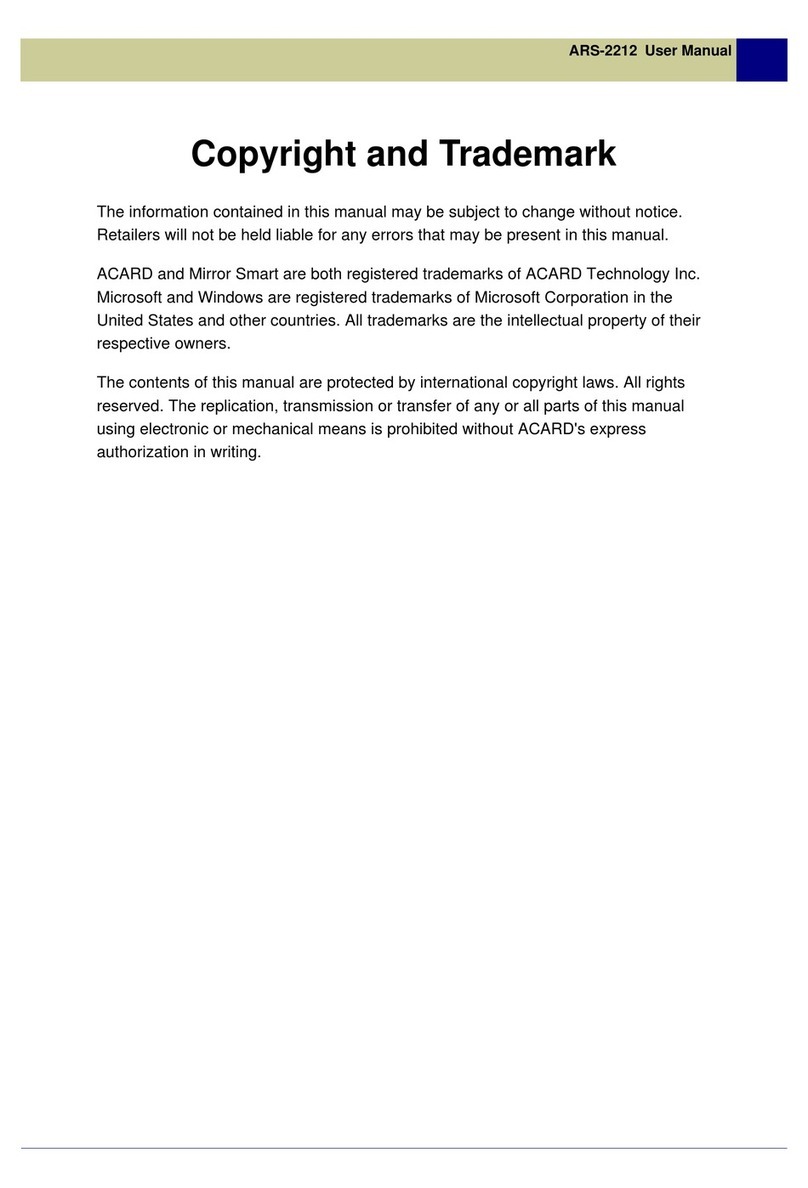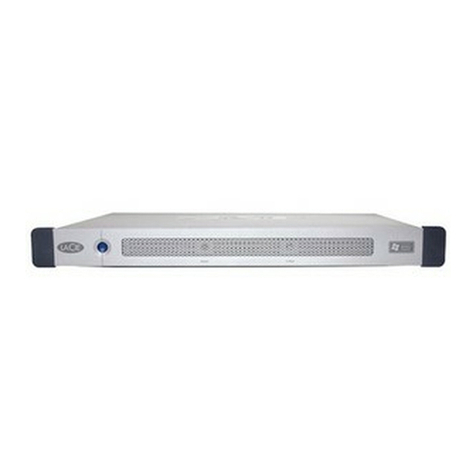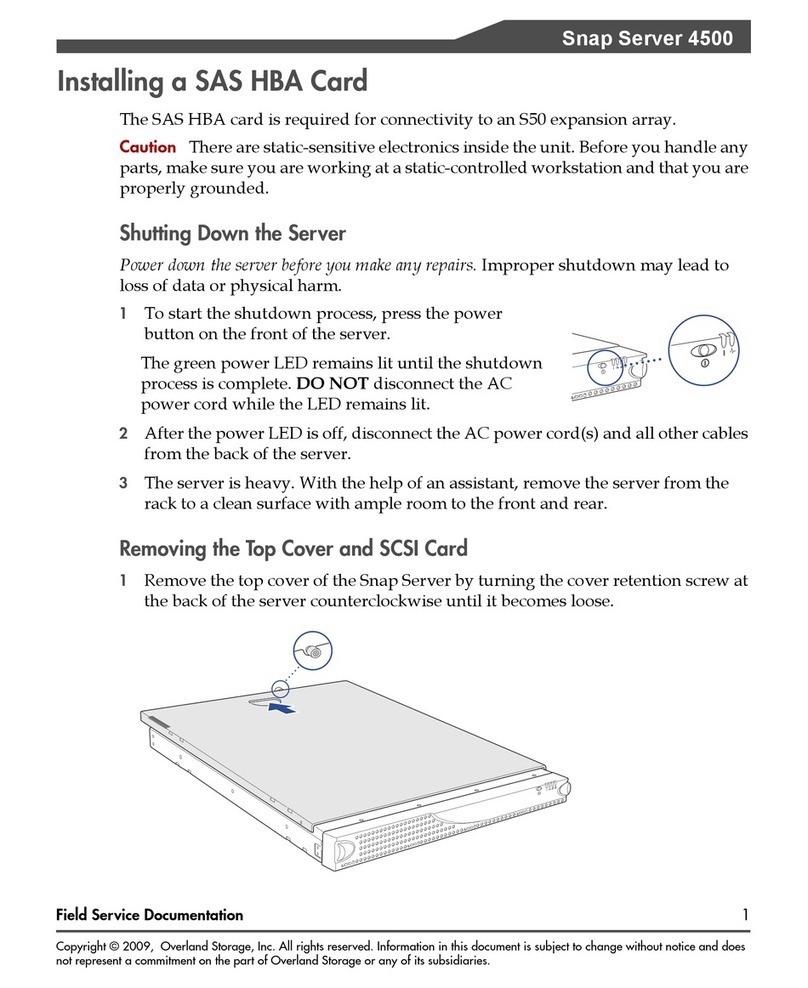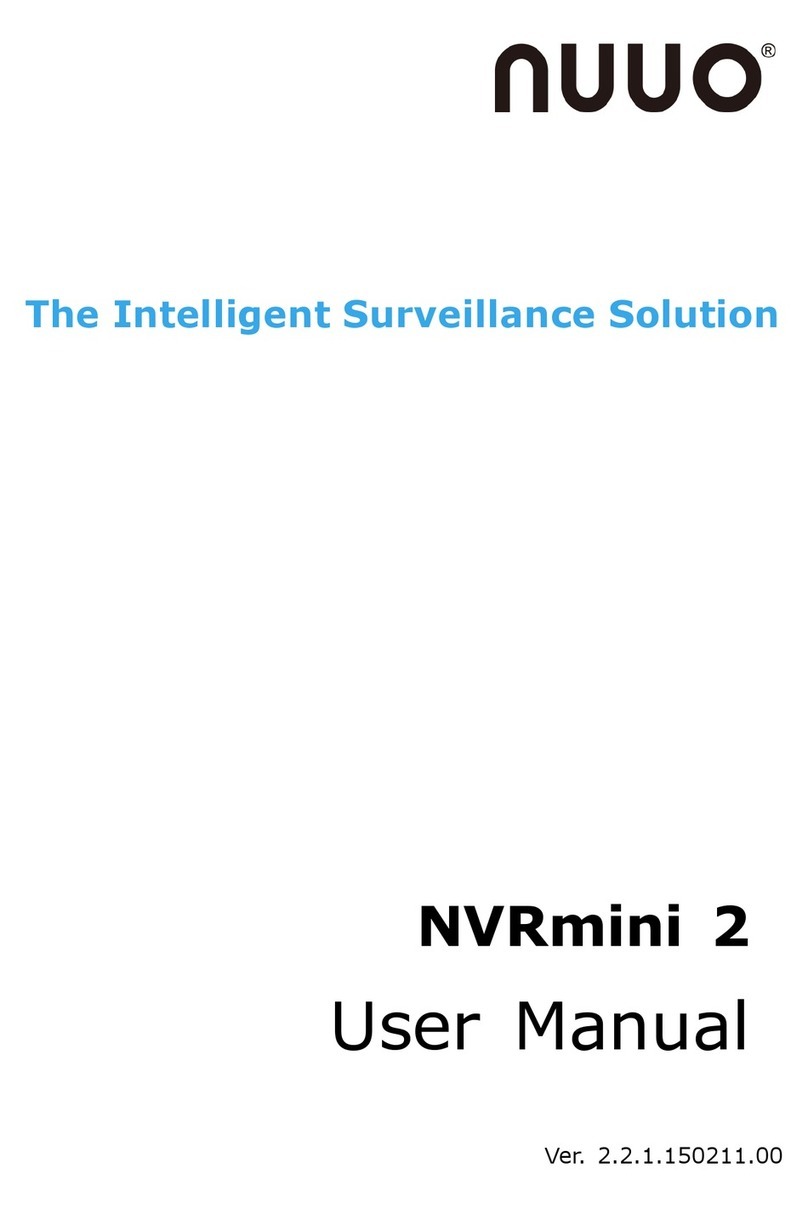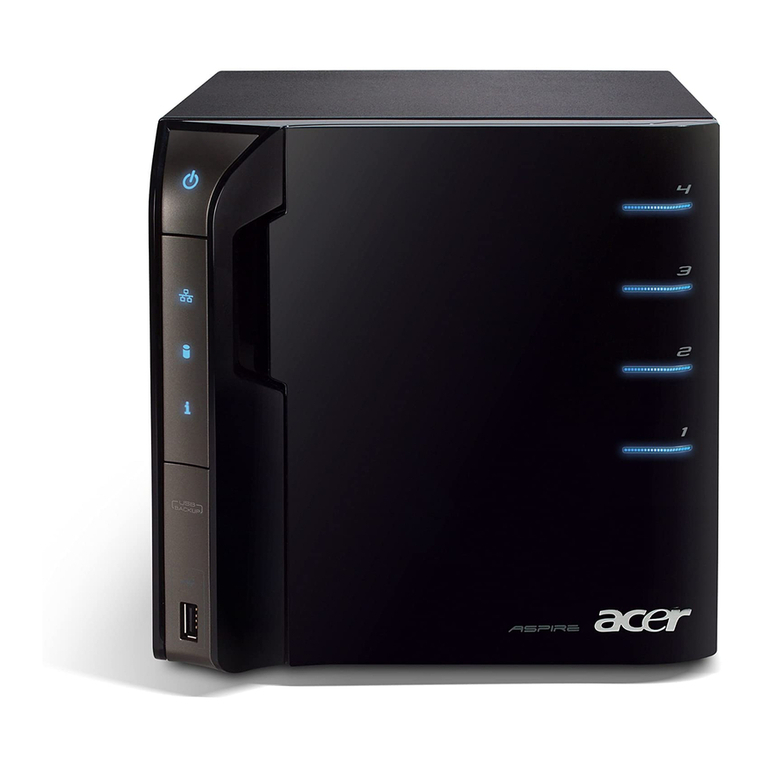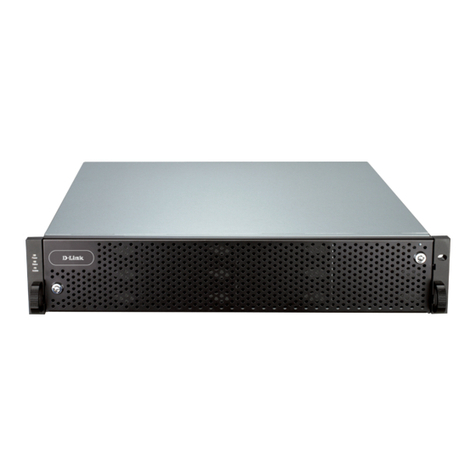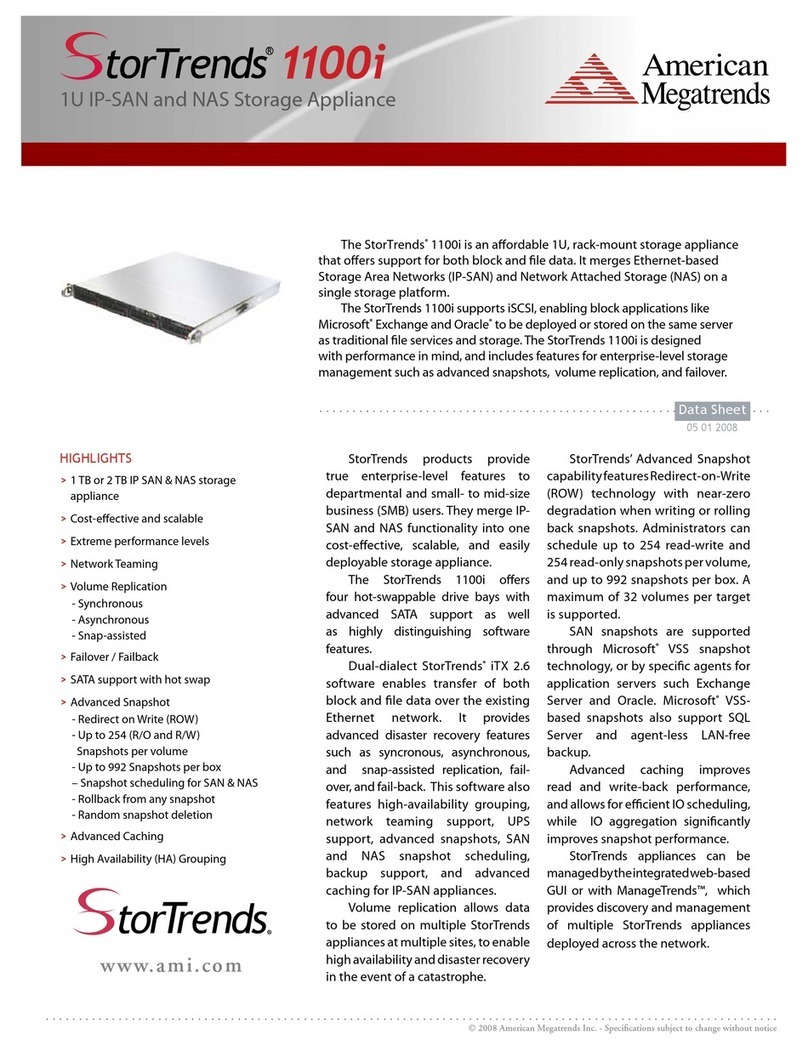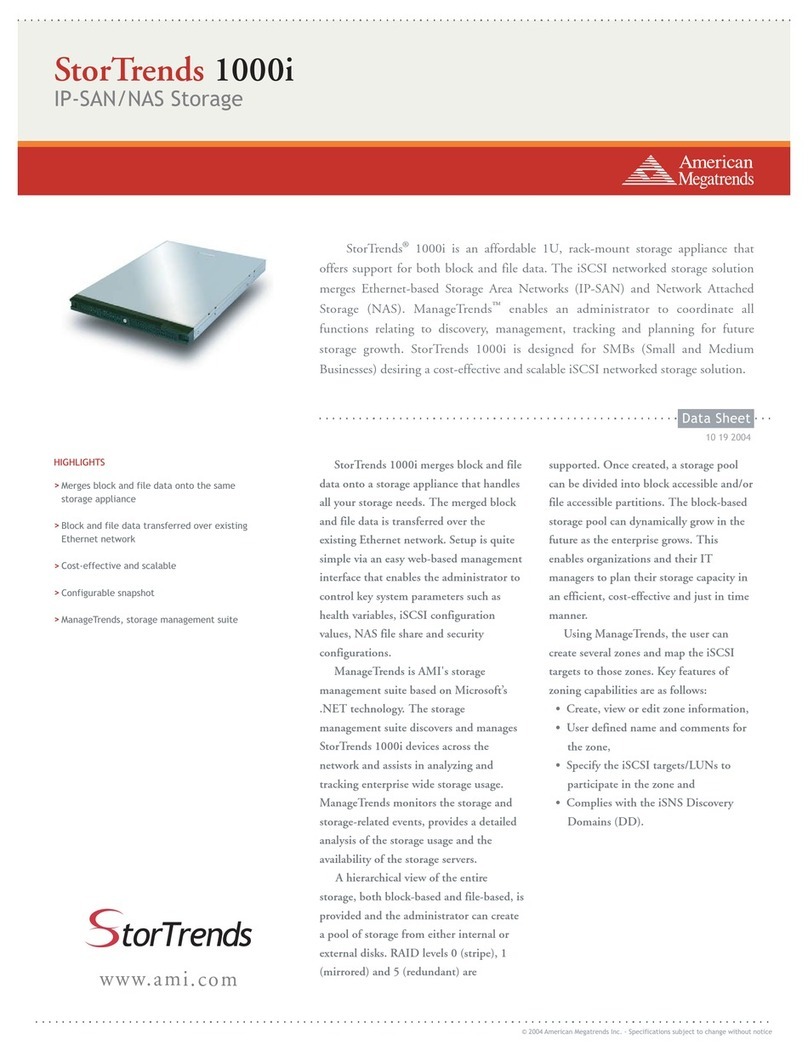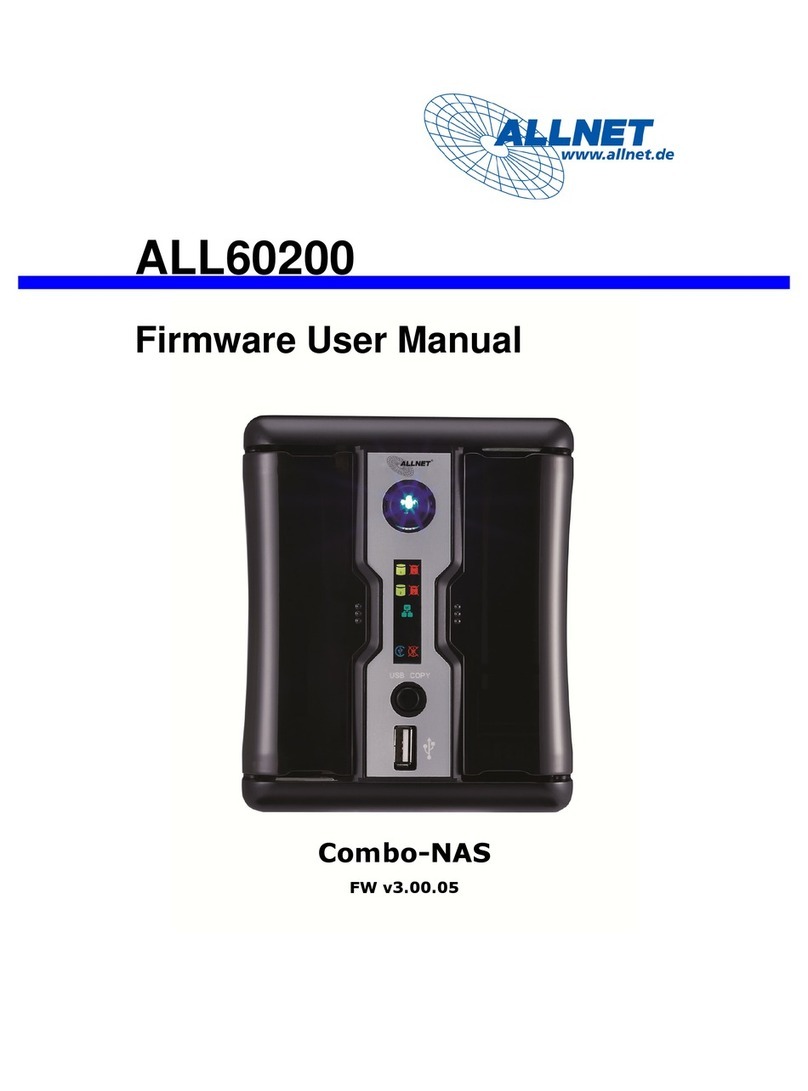Proware SN-3163S3H-QX User manual

SAS/SATA II NAS System
User Manual
Revision 1.1
P/N: PW0020000000365

SAS / SATA II NAS System
2 User Manual
Table of Contents
Preface................................................................................................................................7
FCC Compliance Statement............................................................................................8
Before You Begin .............................................................................................................9
PART I Hardware Components and RAID Subsystem.....................................10
Chapter 1 Introduction.............................................................................................11
1.1 Key Features........................................................................................................................................................... 12
1.2 Technical Specifications..................................................................................................................................... 13
1.3 RAID Concepts ...................................................................................................................................................... 16
1.4 Array Definition..................................................................................................................................................... 21
1.4.1 Raid Set ........................................................................................................................................................... 21
1.4.2 Volume Set .................................................................................................................................................... 21
1.5 High Availability.................................................................................................................................................... 22
1.5.4.1 Creating Hot Spares.......................................................................................................................... 22
1.5.4.2 Hot-Swap Disk Drive Support....................................................................................................... 22
1.5.4.3 Hot-Swap Disk Rebuild..................................................................................................................... 22
Chapter 2 Installation Overview ...........................................................................23
2.1 Packaging, Shipment and Delivery............................................................................................................... 23
2.2 Unpacking the NAS System............................................................................................................................. 23
2.3 Identifying Parts of the NAS System ........................................................................................................... 24
2.3.1 Front View ...................................................................................................................................................... 24
2.3.2 Rear View........................................................................................................................................................ 26
Chapter 3 Getting Started with the NAS System..............................................28
3.1 Connecting the NAS to your Network........................................................................................................ 28
3.2 Powering On ..........................................................................................................................................................28
3.3 Installing Hard Drives......................................................................................................................................... 30
3.4 Connecting SAS JBOD Enclosures and/or RAID with SAS JBOD ..................................................... 31
Chapter 4 RAID Configuration Utility Options ..................................................33
4.1 Configuration through Terminal.................................................................................................................... 33
4.2 Configuration through the LCD Panel ........................................................................................................ 39
4.2.1 Menu Diagram ............................................................................................................................................. 40
4.3 Configuration through web browser-based proRAID Manager....................................................... 45
Chapter 5 RAID Management.................................................................................47

SAS / SATA II NAS System
User Manual 3
5.1 Quick Function ...................................................................................................................................................... 47
5.1.1 Quick Create.................................................................................................................................................. 47
5.2 RAID Set Functions.............................................................................................................................................. 49
5.2.1 Create RAID Set ...........................................................................................................................................49
5.2.2 Delete RAID Set ........................................................................................................................................... 50
5.2.3 Expand RAID Set.......................................................................................................................................... 51
5.2.4 Offline RAID Set........................................................................................................................................... 54
5.2.5 Activate Incomplete RAID Set................................................................................................................ 55
5.2.6 Create Hot Spare......................................................................................................................................... 57
5.2.7 Delete Hot Spare......................................................................................................................................... 57
5.2.8 Rescue Raid Set ........................................................................................................................................... 58
5.3 Volume Set Function.......................................................................................................................................... 59
5.3.1 Create Volume Set...................................................................................................................................... 59
5.3.2 Create Raid 30/50/60 ................................................................................................................................ 62
5.3.3 Delete Volume Set...................................................................................................................................... 63
5.3.4 Modify Volume Set..................................................................................................................................... 64
5.3.4.1 Volume Set Expansion...................................................................................................................... 65
5.3.4.2 Volume Set Migration ...................................................................................................................... 66
5.3.5 Check Volume Set....................................................................................................................................... 67
5.3.6 Schedule Volume Check........................................................................................................................... 69
5.3.7 Stop Volume Check.................................................................................................................................... 70
5.4 Physical Drive......................................................................................................................................................... 70
5.4.1 Create Pass-Through Disk ....................................................................................................................... 70
5.4.2 Modify a Pass-Through Disk .................................................................................................................. 71
5.4.3 Delete Pass-Through Disk ....................................................................................................................... 71
5.4.4 Identify Enclosure........................................................................................................................................ 72
5.4.5 Identify Selected Drive.............................................................................................................................. 73
5.5 System Controls.................................................................................................................................................... 74
5.5.1 System Configuration................................................................................................................................ 74
5.5.2 EtherNet Configuration............................................................................................................................. 76
5.5.2.1 DHCP Host Name Support............................................................................................................. 76
5.5.3 Alert By Mail Configuration .................................................................................................................... 77
5.5.4 SNMP Configuration.................................................................................................................................. 78
5.5.5 NTP Configuration ...................................................................................................................................... 79
5.5.6 View Events / Mute Beeper .................................................................................................................... 80
5.5.7 Generate Test Event................................................................................................................................... 81
5.5.8 Clear Event Buffer ....................................................................................................................................... 81
5.5.9 Modify Password......................................................................................................................................... 82
5.5.10 Upgrade Firmware.................................................................................................................................... 82
5.5.11 Restart Controller...................................................................................................................................... 82

SAS / SATA II NAS System
4 User Manual
5.6 Information Menu................................................................................................................................................ 83
5.6.1 RAID Set Hierarchy..................................................................................................................................... 83
5.6.2 System Information .................................................................................................................................... 84
5.6.3 Hardware Monitor....................................................................................................................................... 85
Chapter 6 System Maintenance.............................................................................86
6.1 Upgrading the RAID Controller’s Cache Memory.................................................................................. 86
6.1.1 Installing Memory Module...................................................................................................................... 86
6.2 Upgrading the RAID Controller’s Firmware .............................................................................................. 87
PART II proNAS System...........................................................................................94
Chapter 7 Introduction.............................................................................................95
7.1 proNAS Key Components................................................................................................................................. 95
7.2 Installation and Configuration Phases......................................................................................................... 96
7.3 Basic Setup Instructions in Creating Raid Set and Volume Set ....................................................... 97
7.4 Setting proNAS IP Address and Connecting to NAS Management GUI....................................100
Chapter 8 proNAS Manager.................................................................................. 102
8.1 Volume Manager ...............................................................................................................................................103
8.1.1 Volume Group Management ...............................................................................................................104
8.1.1.1 Create the proNASVG Volume Group.....................................................................................104
8.1.1.2 Creating another Volume Group...............................................................................................107
8.1.1.3 Reset and Remove Volume Group ...........................................................................................110
8.1.2 Logical Volume Configuration.............................................................................................................112
8.1.2.1 Create new Logical Volume.........................................................................................................112
8.1.2.2 Extending Logical Volume Size ..................................................................................................114
8.1.3 Volume Snapshot......................................................................................................................................116
8.1.3.1 Create Snapshots Manually..........................................................................................................117
8.1.3.2 Create Snapshots Based from Schedule.................................................................................119
8.1.3.3 Delete Snapshots..............................................................................................................................122
8.1.4 Volume Replication ..................................................................................................................................124
8.1.4.1 Replication Configuration .............................................................................................................125
8.1.4.2 Checking the status of your replication .................................................................................130
8.1.4.3 Extending logical volume under replication .........................................................................131
8.1.5 iSCSI................................................................................................................................................................132
8.1.5.1 iSCSI Configuration..........................................................................................................................132
8.1.5.2 Disable iSCSI in Logical Volume ................................................................................................135
8.1.5.3 Restore iSCSI to Ordinary Logical Volume............................................................................136
8.2 Network Manager..............................................................................................................................................138
8.2.1 Network Setting and Trunking............................................................................................................138
8.2.2 Internet Gateway .......................................................................................................................................142

SAS / SATA II NAS System
User Manual 5
8.2.3 SNMP/MRTG ...............................................................................................................................................143
8.3 Account Manager ..............................................................................................................................................144
8.3.1 External Accounts Integration (Joining Windows or NIS Domain).......................................144
8.3.1.1 Windows Authentication...............................................................................................................144
8.3.1.2 Sample Steps to Join the NAS to Windows AD Domain:...............................................145
8.3.1.3 NIS Authentication...........................................................................................................................147
8.3.1.4 Sample Steps to Join NIS Domain:...........................................................................................147
8.3.2 Local Account and Group Management .........................................................................................148
8.4 Share Manager....................................................................................................................................................156
8.4.1 Share Management..................................................................................................................................157
8.4.1.1 Creating a New Share ....................................................................................................................157
8.4.1.2 Applying ACL......................................................................................................................................158
8.4.1.3 Modifying a Share............................................................................................................................158
8.4.1.4 Deleting a Share ...............................................................................................................................159
8.4.2 Properties Setting......................................................................................................................................160
8.4.3 Protocol Setting.........................................................................................................................................161
8.4.3.1 CIFS ........................................................................................................................................................161
8.4.3.2 NFS.........................................................................................................................................................162
8.4.3.3 AppleTalk .............................................................................................................................................162
8.4.3.4 Novell ....................................................................................................................................................162
8.4.4 Privilege Setting.........................................................................................................................................164
8.4.4.1 Group ....................................................................................................................................................164
8.4.4.2 Account.................................................................................................................................................165
8.4.4.3 IP Address............................................................................................................................................167
8.4.5 Rsync ..............................................................................................................................................................169
8.4.6 Duplication...................................................................................................................................................174
8.4.7 Default Share ..............................................................................................................................................178
8.5 System Manager.................................................................................................................................................179
8.5.1 Information tab..........................................................................................................................................180
8.5.2 Upgrade tab ................................................................................................................................................181
8.5.3 Report tab....................................................................................................................................................182
8.5.4 Time tab........................................................................................................................................................183
8.5.5 Serial Ports tab...........................................................................................................................................184
8.5.6 Power tab .....................................................................................................................................................185
8.5.7 Reboot tab...................................................................................................................................................186
8.5.8 Service tab....................................................................................................................................................187
8.5.9 Status tab .....................................................................................................................................................190
8.5.10 MRTG tab...................................................................................................................................................191
8.6 Backup Manager...............................................................................................................................................192
8.6.1 proNAS Configuration Backup ............................................................................................................193

SAS / SATA II NAS System
6 User Manual
8.6.2 Configure Backup Plan............................................................................................................................194
8.6.3 Tape Control................................................................................................................................................199
8.7 Log Manager........................................................................................................................................................200
8.8 Event Manager....................................................................................................................................................201
8.8.1 E-mail Setting tab .....................................................................................................................................201
8.8.2 Event Setting tab.......................................................................................................................................202
Chapter 9 File Manager ......................................................................................... 203
9.1 Introduction to File Manager........................................................................................................................203
9.2 Logon to File Manager....................................................................................................................................205
9.3 Directory and Upload Function....................................................................................................................206
9.4 User Access Right and Group Access Right ...........................................................................................208
9.5 Change Password and Logout .....................................................................................................................208
Chapter 10 proBackup........................................................................................... 209
10.1 Introduction to proBackup ..........................................................................................................................209
10.2 Administrator Logon ......................................................................................................................................209
10.3 Create Backup Plan.........................................................................................................................................212
10.4 Restore Backup.................................................................................................................................................218
10.5 Account Detail ..................................................................................................................................................219
Chapter 11 proNAS HA (Optional Function).................................................... 220
11.1 Introduction to proNAS HA ........................................................................................................................220
11.2 Getting Started with proNAS HA..............................................................................................................221
11.2.1 Hardware Aspect.....................................................................................................................................222
11.2.2 Procedure for Setting Up proNAS HA...........................................................................................223
11.3 ProNAS HA Properties...................................................................................................................................232
11.4 Extending a Logical Volume in HA..........................................................................................................233
11.5 Clear All HA Configuration..........................................................................................................................234
11.6 License Registration........................................................................................................................................236
11.7 Event Log Properties......................................................................................................................................237

SAS / SATA II NAS System
User Manual 7
Preface
About this manual
his manual provides information regarding the hardware features, installation
and configuration of the SAS/SATA II NAS System. This document also
describes the use of the storage management software. Information contained
in the manual has been reviewed for accuracy, but not for product warranty
because of the various environment/OS/settings. Information and specifications
will be changed without further notice. Some pictures and screenshots might be
different with the actual machine.
This manual uses section numbering for every topic being discussed for easy and
convenient way of finding information in accordance with the user’s needs. The following
icons are being used for some details and information to be considered in going through
with this manual:
Copyright
No part of this publication may be reproduced, stored in a retrieval system, or
transmitted in any form or by any means, electronic, mechanical, photocopying,
recording or otherwise, without the prior written consent.
Trademarks
All products and trade names used in this document are trademarks or registered
trademarks of their respective owners.
Changes
The material in this document is for information only and is subject to change without
notice.
IMPORTANT!
These are the important information that the user must
remember.
WARNING!
These are the warnings that the user must follow to avoid
unnecessary errors and bodily injury during hardware and
software operation of the subsystem.
CAUTION:
These are the cautions that user must be aware of to
prevent damage to the equipment and its components.
NOTES:
These are notes that contain useful information and tips
that the user must give attention to in going through
with the subsystem operation.

SAS / SATA II NAS System
8 User Manual
FCC Compliance Statement
This equipment has been tested and found to comply with the limits for a Class B digital
device, pursuant to Part 15 of the FCC rules. These limits are designed to provide
reasonable protection against harmful interference in residential installations. This
equipment generates, uses, and can radiate radio frequency energy, and if not installed
and used in accordance with the instructions, may cause harmful interference to radio
communications.
However, there is not guarantee that interference will not occur in a particular
installation. If this equipment does cause interference to radio or television equipment
reception, which can be determined by turning the equipment off and on, the user is
encouraged to try to correct the interference by one or more of the following measures:
1. Reorient or relocate the receiving antenna
2. Move the equipment away from the receiver
3. Plug the equipment into an outlet on a circuit different from that to which the
receiver is powered.
4. Consult the dealer or an experienced radio/television technician for help
All external connections should be made using shielded cables

SAS / SATA II NAS System
User Manual 9
Before You Begin
efore going through with this manual, you should read and focus on the
following safety guidelines. Information about the NAS system’s packaging
and delivery are also included. To provide reasonable protection against any
harm on the part of the user and to obtain maximum performance, user is
advised to be aware of the following safety guidelines particularly in
handling hardware components:
Upon receiving of the product:
Place the product in its proper location.
To avoid unnecessary dropping out, make sure that somebody is around for
immediate assistance.
It should be handled with care to avoid dropping that may cause damage to the
product. Always use the correct lifting procedures.
Upon installing of the product:
Ambient temperature is very important for the installation site. It must not
exceed 30◦C. Due to seasonal climate changes; regulate the installation site
temperature making it not to exceed the allowed ambient temperature.
Before plugging-in any power cords, cables and connectors, make sure that the
power switches are turned off. Disconnect first any power connection if the power
supply module is being removed from the enclosure.
Outlets must be accessible to the equipment.
All external connections should be made using shielded cables and as much as
possible should not be performed by bare hand. Using anti-static hand gloves is
recommended.
In installing each component, secure all the mounting screws and locks. Make
sure that all screws are fully tightened. Follow correctly all the listed procedures
in this manual for reliable performance.
Controller Configuration
This NAS system supports single RAID controller configuration.
Packaging, Shipment and Delivery
Before removing the subsystem from the shipping carton, you should visually
inspect the physical condition of the shipping carton.
Unpack and verify that the contents of the shipping carton are complete and in
good condition.
Exterior damage to the shipping carton may indicate that the contents of the
carton are damaged.
If any damage is found, do not remove the components; contact the dealer where
you purchased the subsystem for further instructions.

SAS / SATA II NAS System
10 User Manual
PART I Hardware Components and RAID Subsystem

SAS / SATA II NAS System
User Manual 11
Chapter 1 Introduction
The NAS System
Companies are looking for cost-effective storage solutions which can offer the best
performance, high scalability and reliability. As the number of users and the amount of
data grows, Network Attached Storage is becoming a critical technology and the need for
an optimized solution is becoming an important requirement.
Proware delivers the Simbolo “SN-3163S3H-QX”, which combined direct attached storage
(DAS), iSCSI target device and network attached storage (NAS) solution for flexible and
expandable application, and also together with the proNAS management solution,
proNAS High-Availability and proBackup client backup solution to provide businesses
with the most flexible, scalable, securable and manageable NAS environment. It helps to
control the total cost of ownership for data management.
The SN-3163S3H-QX is an SAS/SATA II NAS/DAS/iSCSI all in one Subsystem with
proNAS 1.1 Operating System. It enhances system availability, and manages complex
storage environments easily. For improving business productivity and minimizing
business risks, SN-3163S3H-QX provides a volume replication and a volume snapshot
function. It is also a full featured data protection system supporting RAID levels 0, 1, 0+1,
3, 5, 6, 30, 50, 60 and JBOD. It supports hot spares, automatic hot rebuild and online
capacity expansion within the enclosure.

SAS / SATA II NAS System
12 User Manual
1.1 Key Features
- Configurable to 19" rack-mountable 3U chassis
- Supports up to Sixteen (16) 1" hot - swappable SAS/SATA II hard drives
- Supports RAID levels 0, 1, 0+1, 3, 5, 6, 30, 50, 60 and JBOD
- Supports NAS, DAS and iSCSI in one system
- Supports two Gigabit Ethernet ports for NAS file-sharing application
- Supports one SAS port for direct RAID connection to a host system
- Support iSCSI target for IP SAN environment
- Supports up to 224 SAS/SATAII disks maximum based on:
* Support one SAS Expansion port to connect up to 6 SAS JBOD enclosures for RAID
expansion (up to 112 disks)
* Support one SAS HBA port to connect second DAS enclosure (SB-3163S-S3S3) to
expand the RAID of NAS (up to next 112 disks with next 6 SAS JBOD)
- Smart-function LCD panel for RAID setting & ENC status
- Supports hot spare and automatic hot rebuild.
- Allows online capacity expansion within the enclosure
- Supports spin down drives for power saving (MAID) and disk drive power cycle
- Supports scheduled volume check for data integrity by RAID 3/5/6
- Linux-based embedded system (128MB Disk on Module)
- Supports Tape/DAT backup/restore
- Centralization of Data and Storage Management
- Using Market-Leading Java Technology
- Latest volume snapshot technology
- Apply volume replication to enhance data protection
- Support logical volume over 2TB
- Data Backup via backup plan and scheduling
- Enhance system configuration backup
- Local and external account management
- Large account import
- Share management and permission
- Advance ACL setting for project share
- Support Internet Gateway function
- Online expansion of file system
- Support E-mail notification and system log information
- Multi application support via proFamily
- Support Samba “MediaHarmony” VFS which allows multiple editing clients to
interoperate with the media files

SAS / SATA II NAS System
User Manual 13
1.2 Technical Specifications
Model Number : SN-3163S3H-QX
Hardware Platform
Intel Quad Core Xeon 2.0G or above, single / dual Processor
Cache memory:2GB DDR2-533 FBDIMM up to 32GB
Two Gigabit Ethernet ports (10 Gigabit Ethernet for additional option)
Up to Sixteen 1" hot-swappable SAS/SATA II (3Gb/s, NCQ support) hard drives
Real time drive activity and status indicators
Environmental monitoring unit
Two (2) 700W hot-swap power supplies with PFC
Expansion PCI slot for H/W upgrade
One (1) 4X SAS Host port for RAID connection to a Host System (volume created from
enclosure is used by other host system)
One (1) 4X SAS Expansion port for JBOD connection (up to 6 SAS JBOD enclosures,
max. 112 disks)
One(1) 4X SAS HBA port for connection to another DAS RAID and JBOD (max. 112
disks with 1 DAS + 6 JBOD enclosures)
RAID Controller
Intel 80341 64 bit RISC
RAID level RAID 0, 1, 0+1, 3, 5, 6, 30, 50, 60 and JBOD
Supports 512MB up to 4GB of ECC cache memory
Supports hot spare and automatic hot rebuild
Support MAID (spin down drives when not in use to extend service)
Allows online capacity expansion within the enclosure
Built-in serial port interface for remote event notification
Local audible event notification alarm
Storage Management
Volume Management
Disk usage statistics
Hot spare capability
Volume Snapshot
Volume Replication

SAS / SATA II NAS System
14 User Manual
Connectivity
iSCSI target
SMB, CIFS over TCP/IP
NFS over UDP/IP
Cross platform data access
Novell Netware support
FTP, HTTP file transfer
DHCP
NAT
Internet gateway
WINS Server
Unit acts as a DHCP server
Unit acts as a master browser
Share level security
File level security
User ID security for NFS
Macintosh Support
AFP over Apple Talk
AFP over TCP/IP
Mac zones
General
File Server Independent
Peer-to-peer operation
Localized language support
Supports NIC / trunking / load balance / fail over
Support UPS management
Support Samba “MediaHarmony”
System Management
Automatic IP address configuration
Self-contained unit - no extras needed
Management through Web browser

SAS / SATA II NAS System
User Manual 15
Flash upgradeable unit
Supports Microsoft ADS / PDC and Unix NIS accounts import
SNMP / MRTG management and notification
Fail-free online firmware upgrade
Unicode support
Multi-node Management GUI
CLI management via Telnet or SSH
Data Protection
proNAS High Availability (option)
proBackup Client Backup
proNAS Data and Configuration Backup
Support Veritas Backup Exec Agent
Power requirements
AC 90V ~ 264V Full range
10A ~ 5A, 47~63Hz
Physical Dimension
133(H) x 482(W) x 716(D) mm
Note: Specifications are subject to change without notice. All company and product names are
trademarks of their respective owners.

SAS / SATA II NAS System
16 User Manual
1.3 RAID Concepts
RAID Fundamentals
The basic idea of RAID (Redundant Array of Independent Disks) is to combine multiple
inexpensive disk drives into an array of disk drives to obtain performance, capacity and
reliability that exceeds that of a single large drive. The array of drives appears to the
host computer as a single logical drive.
Five types of array architectures, RAID 1 through RAID 5, were originally defined; each
provides disk fault-tolerance with different compromises in features and performance. In
addition to these five redundant array architectures, it has become popular to refer to a
non-redundant array of disk drives as a RAID 0 arrays.
Disk Striping
Fundamental to RAID technology is striping. This is a method of combining multiple
drives into one logical storage unit. Striping partitions the storage space of each drive
into stripes, which can be as small as one sector (512 bytes) or as large as several
megabytes. These stripes are then interleaved in a rotating sequence, so that the
combined space is composed alternately of stripes from each drive. The specific type of
operating environment determines whether large or small stripes should be used.
Most operating systems today support concurrent disk I/O operations across multiple
drives. However, in order to maximize throughput for the disk subsystem, the I/O load
must be balanced across all the drives so that each drive can be kept busy as much as
possible. In a multiple drive system without striping, the disk I/O load is never perfectly
balanced. Some drives will contain data files that are frequently accessed and some
drives will rarely be accessed.
By striping the drives in the array with stripes large enough so that each record falls
entirely within one stripe, most records can be evenly distributed across all drives. This
keeps all drives in the array busy during heavy load situations. This situation allows all
drives to work concurrently on different I/O operations, and thus maximize the number
of simultaneous I/O operations that can be performed by the array.

SAS / SATA II NAS System
User Manual 17
Definition of RAID Levels
RAID 0 is typically defined as a group of striped disk drives without parity or data
redundancy. RAID 0 arrays can be configured with large stripes for multi-user
environments or small stripes for single-user systems that access long sequential records.
RAID 0 arrays deliver the best data storage efficiency and performance of any array type.
The disadvantage is that if one drive in a RAID 0 array fails, the entire array fails.
RAID 1, also known as disk mirroring, is simply a pair of disk drives that store duplicate
data but appear to the computer as a single drive. Although striping is not used within a
single mirrored drive pair, multiple RAID 1 arrays can be striped together to create a
single large array consisting of pairs of mirrored drives. All writes must go to both drives
of a mirrored pair so that the information on the drives is kept identical. However, each
individual drive can perform simultaneous, independent read operations. Mirroring thus
doubles the read performance of a single non-mirrored drive and while the write
performance is unchanged. RAID 1 delivers the best performance of any redundant array
type. In addition, there is less performance degradation during drive failure than in RAID
5 arrays.

SAS / SATA II NAS System
18 User Manual
RAID 3 sector-stripes data across groups of drives, but one drive in the group is
dedicated for storing parity information. RAID 3 relies on the embedded ECC in each
sector for error detection. In the case of drive failure, data recovery is accomplished by
calculating the exclusive OR (XOR) of the information recorded on the remaining drives.
Records typically span all drives, which optimizes the disk transfer rate. Because each
I/O request accesses every drive in the array, RAID 3 arrays can satisfy only one I/O
request at a time. RAID 3 delivers the best performance for single-user, single-tasking
environments with long records. Synchronized-spindle drives are required for RAID 3
arrays in order to avoid performance degradation with short records. RAID 5 arrays with
small stripes can yield similar performance to RAID 3 arrays.
Under RAID 5 parity information is distributed across all the drives. Since there is no
dedicated parity drive, all drives contain data and read operations can be overlapped on
every drive in the array. Write operations will typically access one data drive and one
parity drive. However, because different records store their parity on different drives,
write operations can usually be overlapped.
Dual-level RAID achieves a balance between the increased data availability inherent in
RAID 1 and RAID 5 and the increased read performance inherent in disk striping (RAID
0). These arrays are sometimes referred to as RAID 0+1 or RAID 1+0 and RAID 0+5 or
RAID 50.

SAS / SATA II NAS System
User Manual 19
RAID 6 is similar to RAID 5 in that data protection is achieved by writing parity
information to the physical drives in the array. With RAID 6, however, two sets of parity
data are used. These two sets are different, and each set occupies a capacity equivalent
to that of one of the constituent drives. The main advantage of RAID 6 is High data
availability – any two drives can fail without loss of critical data.
In summary:
RAID 0 is the fastest and most efficient array type but offers no fault-tolerance. RAID
0 requires a minimum of one drive.
RAID 1 is the best choice for performance-critical, fault-tolerant environments. RAID
1 is the only choice for fault-tolerance if no more than two drives are used.
RAID 3 can be used to speed up data transfer and provide fault-tolerance in single-
user environments that access long sequential records. However, RAID 3 does not
allow overlapping of multiple I/O operations and requires synchronized-spindle drives
to avoid performance degradation with short records. RAID 5 with a small stripe size
offers similar performance.
RAID 5 combines efficient, fault-tolerant data storage with good performance
characteristics. However, write performance and performance during drive failure is
slower than with RAID 1. Rebuild operations also require more time than with RAID 1
because parity information is also reconstructed. At least three drives are required
for RAID 5 arrays.
RAID 6 is essentially an extension of RAID level 5 which allows for additional fault
tolerance by using a second independent distributed parity scheme (two-dimensional
parity). Data is striped on a block level across a set of drives, just like in RAID 5, and
a second set of parity is calculated and written across all the drives; RAID 6 provides
for an extremely high data fault tolerance and can sustain multiple simultaneous
drive failures. It is a perfect solution for mission critical applications.

SAS / SATA II NAS System
20 User Manual
RAID Management
The subsystem can implement several different levels of RAID technology. RAID levels
supported by the subsystem are shown below.
RAID Level Description Min. Drives
0 Block striping is provide, which yields
higher performance than with individual
drives. There is no redundancy. 1
1 Drives are paired and mirrored. All data is
100% duplicated on an equivalent drive.
Fully redundant. 2
3 Data is striped across several physical
drives. Parity protection is used for data
redundancy. 3
5 Data is striped across several physical
drives. Parity protection is used for data
redundancy. 3
6
Data is striped across several physical
drives. Parity protection is used for data
redundancy. Requires N+2 drives to
implement because of two-dimensional
parity scheme
4
1 + 0 Combination of RAID levels 0 and 1. This
level provides striping and redundancy
through mirroring. 4
30
Combination of RAID levels 0 and 3. This
level is best implemented on two RAID 3
disk arrays with data striped across both
disk arrays.
6
50
RAID 50 provides the features of both RAID
0 and RAID 5. RAID 50 includes both parity
and disk striping across multiple drives.
RAID 50 is best implemented on two RAID 5
disk arrays with data striped across both
disk arrays.
6
60
RAID 60 combines both RAID 6 and RAID 0
features. Data is striped across disks as in
RAID 0, and it uses double distributed
parity as in RAID 6. RAID 60 provides data
reliability, good overall performance and
supports larger volume sizes.
RAID 60 also provides very high reliability
because data is still available even if
multiple disk drives fail (two in each disk
array).
8
Table of contents
Other Proware Network Storage Server manuals
